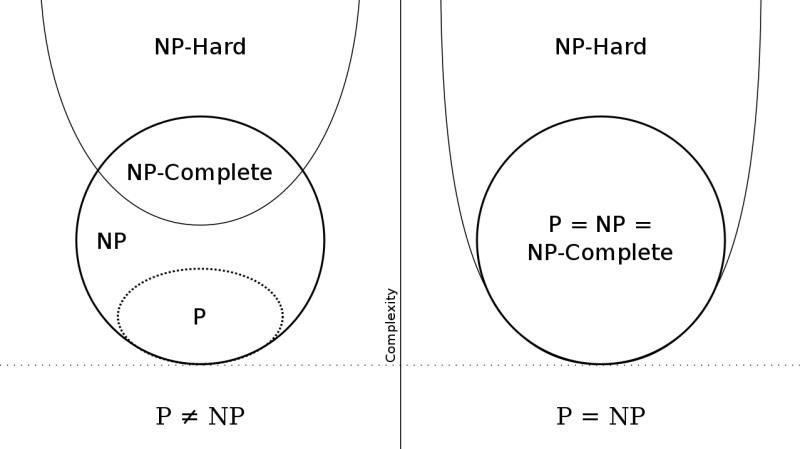Solving this problem, you will have all of Bitcoin in the world
- Tram Ho
If you successfully solve the problem P compared to NP, you will earn billions of dollars.
P compared to NP (quick solution compared to rapid verification) is an important open problem in computer science theory. It can be described as simple as this: If a problem with a solution can be verified quickly, can it be found quickly?
For example, Sudoku games, though very difficult, are easy to check (just add rows, columns and diagonal lines), that’s the problem.
P, compared with NP, was developed by Stephen Cook in 1971 in the famous article of complexity of theorem proving procedures, which is considered by many to be the most important problem in computer science.
 Diagram showing the problem classes need to prove to P = NP. Photo: Behnam Esfahbod.
Diagram showing the problem classes need to prove to P = NP. Photo: Behnam Esfahbod.
This is also one of the seven millennium problems chosen by the Clay Mathematical Institute. Each of these seven articles has a prize of $ 1,000,000 for the first correct answer.
The solution to the problem of P versus NP will show whether all problems in NP, such as the subset problem, have algorithms implemented in polynomial time. If P ≠ NP, there are many problems in NP (such as full NP – problems) whose solution can be verified in polynomial time (some finite time period can be calculated ) but cannot find such a solution in polynomial time.
The problem opens the gold store
Computer scientist Scott Aaronson explained at a lecture at the Los Alamos National Laboratory in New Mexico, proving P = NP opens up some interesting possibilities.
If someone solves the P problem compared to NP, the first thing they do is get $ 200 billion in global Bitcoin value. The second thing is to continue to solve all other millennium problems. At this point, they will take humanity “evolution” one step further.
To understand why so, it is necessary to know that computers are problem-solving devices, in which abstract information is readable by physical devices, based on the principles proposed by Alan Turing. Solving the problem takes a certain number of steps and time, the amount of time required will increase as the problem grows.
 P compared to NP was given by Stephen Cook in 1971 in “The complexity of theorem proving procedures”. Photo: Kevin Van Paassen.
P compared to NP was given by Stephen Cook in 1971 in “The complexity of theorem proving procedures”. Photo: Kevin Van Paassen.
From simply multiplying two numbers to more complex tasks such as using an Internet browser, the computer is basically trying to solve addition and subtraction multiplication operations.
When a development problem is complex, the amount of time required to solve increases in polynomial time. Polynomials are a power factor and a factor (such as n powers 2). If a problem can be solved during n caps 2, when doubling the size of the problem (2n), the amount of time it takes to solve it will increase four times (2n power 2).
As such, all computer tasks can be calculated after how long the computer resolves the problem.
Solve and verify
There are many problems in which one can test an answer right in polynomial time (calculate the time to answer the answer), but the process of getting that answer may not be time. Polynomial (ie, the solution can be found or no solution is found in a certain time period, it is impossible to determine exactly how long it will take to find the solution).
This is called the “Nondeterministic Polynomial time” NP problem – an indeterminate polynomial time problem.
Sudoku is a difficult problem to solve, easy to check. Another important example is separating a number into prime numbers. It takes a very long time, slower than the polynomial time to separate very large numbers into prime numbers. However, checking that the correct answer is not simply multiplying the numbers together. This idea is the foundation of modern encryption, based on creating security keys that are easy to verify but hard to crack.
 If you prove that P = NP, you will break the entire world security system, not just Bitcoin. Photo: Cryptoline News.
If you prove that P = NP, you will break the entire world security system, not just Bitcoin. Photo: Cryptoline News.
People used to think that quantum computers can solve the most difficult NP problems, called full NP-problems. But as expected, quantum computers can only solve some P problems in shorter time (lower polynomials) or convert some NP problems to the quantum generalization of P, called BQP or Bounded-Error error polynomial time.
Since P = NP has not yet been proven, our entire coding system is still secure. Hackers take longer to crack the keys than the time to create them. Bitcoin is also based on this encryption platform, so it is still a safe currency.
If you can find an effective solution for NP-complete problems, you can find effective solutions for all NP issues. This allows you to solve a variety of other similar optimization problems.
If you succeed in proving P by NP, you will earn at least $ 1 million, even more. If it fails, it shows that global encryption systems are still secure.
Source : Zing
